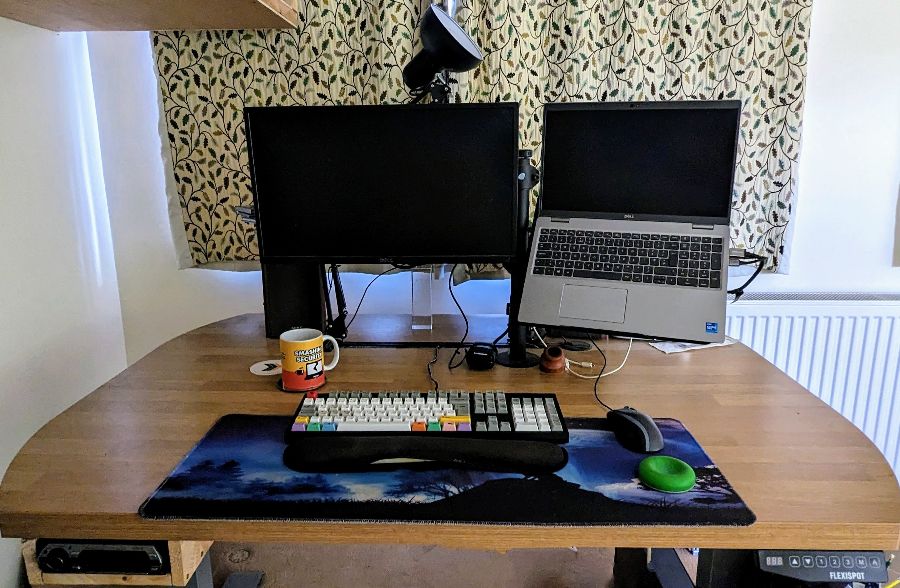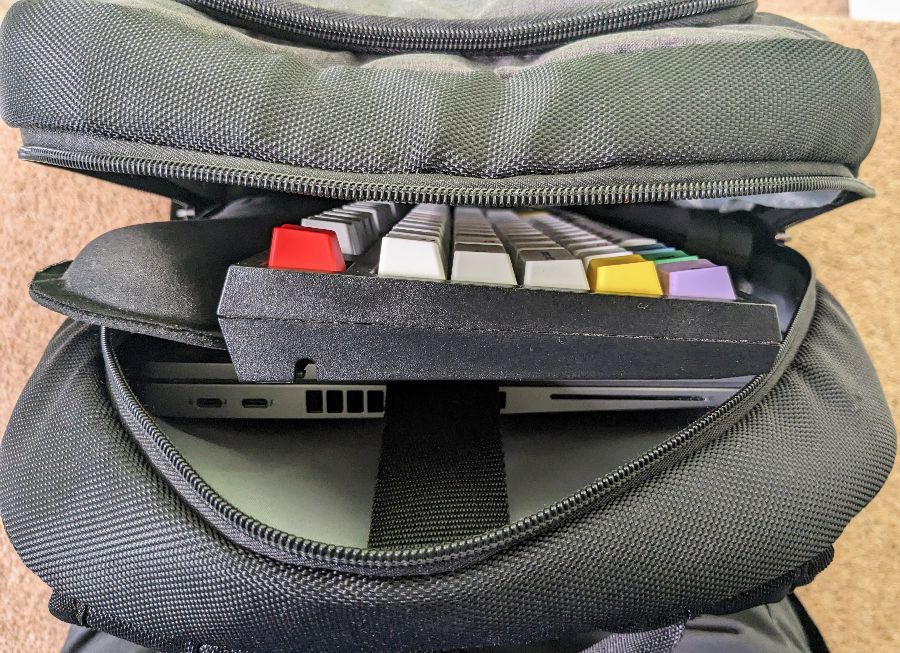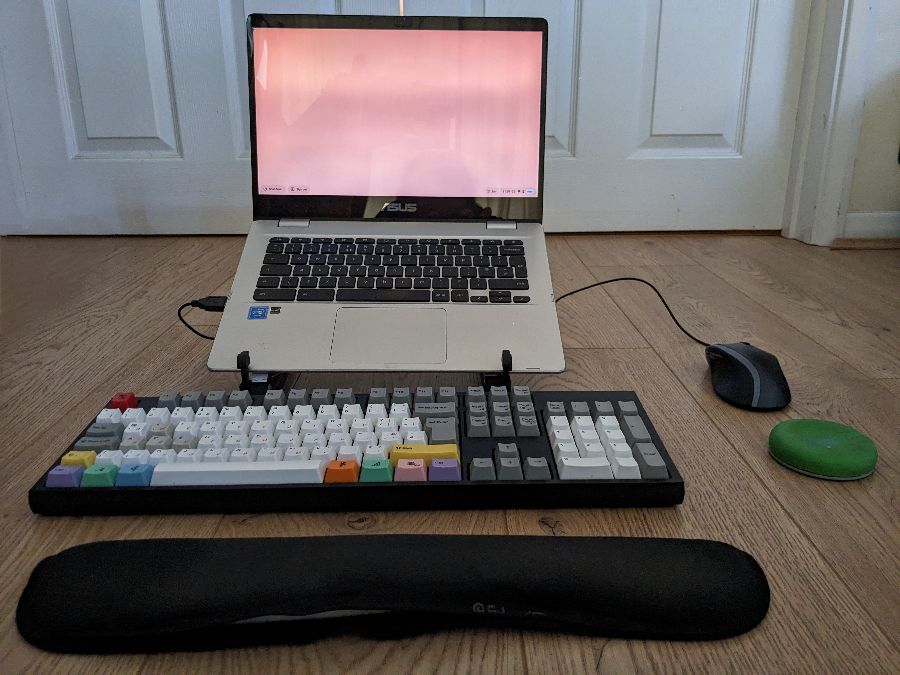Things I need on my desk

I saw a tweet from a computer company recently that asked people to name three things they needed on their desk. One person responded "monitor, keyboard, mouse - that was easy", but this got me wondering about what things I need versus the things that I want, or that make me more effective. I'm not going to limit my post to just three things though 🙂.
What do I need?
If I'm purely considering my gaming PC (under the desk), then I do only need a monitor, keyboard and mouse. To game properly though a headset is pretty useful (it's on the desk before it's on my head...). Let's talk about working though.
For my day job I've been laptop based for years. As soon as I moved to work at a local council as an engineer it wasn't going to be feasible to lug a PC around everytime I had to do a site visit! For business use, in my case at least, a laptop works great so long as it's a decent specification - I often run virtual machines for testing / modeling so RAM is my friend, and plenty of it.
So, if I'm just working and considering what I need for the vast majority of my role I can get away with just my laptop and its charger. Indeed, I'm writing part of this blog post from a coffee shop on a laptop and it's working well enough.
What makes me effective?
If I was stuck on a laptop all day, every day, I wouldn't be effective. For a start, my posture would be all wrong, looking down at a screen that's too close to me. I'd likely develop RSI fairly quickly due to the keyboard positioning. Laptop trackpads frustrate me hugely too, so I'd be getting quite irritated. Laptop alone is OK every now and then, and is what I'd carry if I was going to meetings without having a desk.
To be more effective I make use of an external keyboard (my WASD mechanical keyboard), external mouse (currently a Logitech WHAT?) and an additional monitor. Studies have shown that multiple monitors help you to work more effectively, and I certainly feel that's the case for me. Perhaps I'll only need to drop to one if I move to an ultrawide though.
To address the posture issue I make sure my laptop screen is at the right height, as is the external monitor. Use of external peripherals helps reduce the likelihood of RSI, as does use of a keyboard wrist rest (it needs replacing) and a Puk[1] mouse wrist support that was invented by a friend of mine.
Having a decent working environment helps me to be effective because I'm not in pain, and have useful tools
My home desk setup
I've blogged before about my home desk, and how it changed several times over lockdown. I'm using a Flexispot E6 standing desk (reviewed here). The desktop itself is an offcut from my old kitchen worktops and it is 135cm wide by 95cm deep. Lots of space means I can get an extra laptop alongside me if I need it. I try to keep it tidy, but confess I did tidy up for this photo.

You can see the monitor and laptop are mounted, putting them at the right height (or as close as the upright allows) which also keeps them off the desk. My peripherals are on a mat which helps cushion my arms (it overhangs the desk edge slightly, as it's a 90 degree angle rather than a curve).
Things on the desk
Aside from tech, wrist rests and mat, there's also my Good Made Better Penwell (which I need to move, having rearranged the desk) and some coasters (one is made from an old hard disk platter). Usually, there's a pile on each of edge of the desk that are things I either need to work on (e.g. bank statments) or notepads I'm using. The block of glass at the back is my "Atomic Gains" award from work, which I was honoured to receive after only four months at the company by then.
I don't know about you, but I cannot stand it when on a video call with someone and I start to hear my audio feeding back via their microphone. To that end I use a headset, often my Anker Soundcore Q30 active noise cancelling headphones. When not in use they sit on my desk too.
There's almost always at least one beverage on my desk, in the case of that photo in a Smashing Security podcast mug.
Music?
The eagle eyed among you will spot the speakers in the background - re-used after their accompanying hifi died, and a car radio mounted under the left edge of the desk. While not perfectly placed for sound they work acceptably so I have the option of having music on in the background without having to wear headphones. I prefer to have music or a podcast on while I'm working, unless I'm reading a particularly complex document.
My portable setup
Being laptop based means I can pack up my office and go to wherever I'm needed. Fortunately everything I need fits neatly in a Targus CitySmart Essential Business Backpack (model TSB911-70). That's not big enough for me to also carry more than a day's change of clothes, so if I'm travelling for a longer period I switch to another bag, but when going into the office it's that Targus that I use. My headphones don't fit in the bag, but as they have a separate case I clip that to the rucksack's handle using a caribiner.
In the main section of the bag I can fit my laptop, WASD keyboard (yep, it travels with me), laptop stand and keyboard wrist rest, plus associated cables. The front pocket contains my mouse and Puk wrist rest, with a few other useful odds and ends.

When I get to my destination desk I'll setup the laptop stand and external peripherals a bit like in the photograph below. (Please ignore the fact that's setup on the floor - trying to find clear table space at home can be a challenge!!)

If the desk I'm visiting has an external monitor I'll use that too.
Conclusions
Having the right setup can help me be more comfortable and more effective. I'd recommend you look at your setup too. There's always room for improvement and change.
Kit list
For those interested, my standard kit list:
- External monitor, 24"
- Laptop (either an Asus Chromebook C423NA Touch (review), HP Probook, Dell Latitude 5520)
- Keyboard wrist rest
- Puk mouse wrist rest
- Desk mat
- WASD Keyboard (review)
- Logitech M500 / M-U0007 "almost any surface" mouse
- Anker Soundcore Q30 noise cancelling headphones
- USB-C HDMI adapter
- USB gigabit network card
Banner image: A view of my (tidied) desk.
[1] The Puk is available from its dedicated website, or on Amazon (much more expensive than buying direct). Research among my family shows it works for about 50% of us, so your mileage may vary! I wouldn't be without mine.

